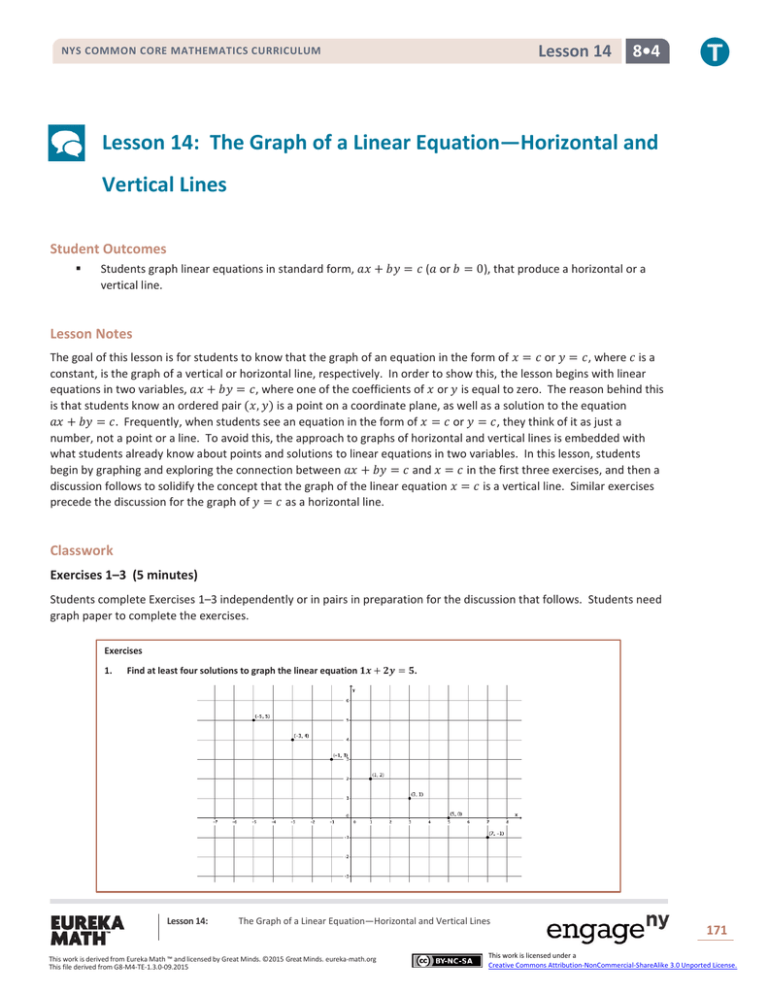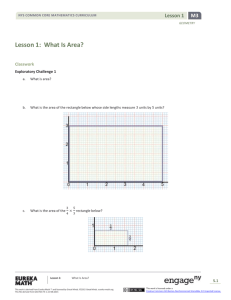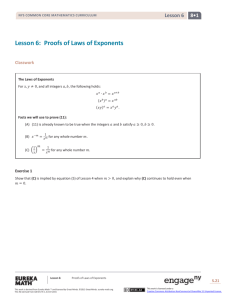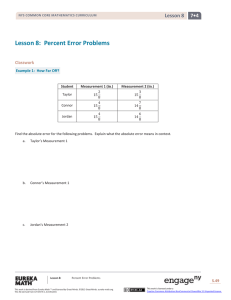Graphing Linear Equations: Horizontal & Vertical Lines
advertisement

Lesson 14 NYS COMMON CORE MATHEMATICS CURRICULUM 8•4 Lesson 14: The Graph of a Linear Equation—Horizontal and Vertical Lines Student Outcomes Students graph linear equations in standard form, 𝑎𝑥 + 𝑏𝑦 = 𝑐 (𝑎 or 𝑏 = 0), that produce a horizontal or a vertical line. Lesson Notes The goal of this lesson is for students to know that the graph of an equation in the form of 𝑥 = 𝑐 or 𝑦 = 𝑐, where 𝑐 is a constant, is the graph of a vertical or horizontal line, respectively. In order to show this, the lesson begins with linear equations in two variables, 𝑎𝑥 + 𝑏𝑦 = 𝑐, where one of the coefficients of 𝑥 or 𝑦 is equal to zero. The reason behind this is that students know an ordered pair (𝑥, 𝑦) is a point on a coordinate plane, as well as a solution to the equation 𝑎𝑥 + 𝑏𝑦 = 𝑐. Frequently, when students see an equation in the form of 𝑥 = 𝑐 or 𝑦 = 𝑐, they think of it as just a number, not a point or a line. To avoid this, the approach to graphs of horizontal and vertical lines is embedded with what students already know about points and solutions to linear equations in two variables. In this lesson, students begin by graphing and exploring the connection between 𝑎𝑥 + 𝑏𝑦 = 𝑐 and 𝑥 = 𝑐 in the first three exercises, and then a discussion follows to solidify the concept that the graph of the linear equation 𝑥 = 𝑐 is a vertical line. Similar exercises precede the discussion for the graph of 𝑦 = 𝑐 as a horizontal line. Classwork Exercises 1–3 (5 minutes) Students complete Exercises 1–3 independently or in pairs in preparation for the discussion that follows. Students need graph paper to complete the exercises. Exercises 1. Find at least four solutions to graph the linear equation 𝟏𝒙 + 𝟐𝒚 = 𝟓. Lesson 14: The Graph of a Linear Equation—Horizontal and Vertical Lines This work is derived from Eureka Math ™ and licensed by Great Minds. ©2015 Great Minds. eureka-math.org This file derived from G8-M4-TE-1.3.0-09.2015 171 This work is licensed under a Creative Commons Attribution-NonCommercial-ShareAlike 3.0 Unported License. Lesson 14 NYS COMMON CORE MATHEMATICS CURRICULUM 2. Find at least four solutions to graph the linear equation 𝟏𝒙 + 𝟎𝒚 = 𝟓. 3. What was different about the equations in Exercises 1 and 2? What effect did this change have on the graph? 8•4 In the first equation, the coefficient of 𝒚 was 𝟐. In the second equation, the coefficient of 𝒚 was 𝟎. The graph changed from being slanted to a vertical line. Discussion (14 minutes) From Lesson 13, we can say that the graph of a linear equation in two variables looks like a line. We want to be able to prove that the graph is a line, not just predict. For that reason, we will begin with two special cases of linear equations in two variables. Given a linear equation in two variables 𝑎𝑥 + 𝑏𝑦 = 𝑐, where 𝑎, 𝑏, and 𝑐 are constants, we will look first at Case 1, where 𝑎 = 1 and 𝑏 = 0. (In the past, we have said that 𝑎 and 𝑏 ≠ 0). To do some investigating, let’s say that 𝑐 = 5. Then we have the following equation: 1 ⋅ 𝑥 + 0 ⋅ 𝑦 = 5. For the linear equation 1 ⋅ 𝑥 + 0 ⋅ 𝑦 = 5, we want to find solutions, (𝑥, 𝑦), to plot as points on a coordinate plane. How have we found solutions in prior lessons? We find solutions by picking a number for 𝑥 or 𝑦 and then solve for the other variable. The numbers (𝑥, 𝑦) are a solution to the equation. What happens if we pick 7 for 𝑥? Explain. If we pick 7 for 𝑥, then we get 1⋅7+0⋅𝑦 =5 7+0⋅𝑦 =5 0 ⋅ 𝑦 = −2 0 ≠ −2. If we replace 𝑥 with 7, then we get an untrue statement. Therefore, (7, 𝑦) is not a solution to this linear equation. Lesson 14: The Graph of a Linear Equation—Horizontal and Vertical Lines This work is derived from Eureka Math ™ and licensed by Great Minds. ©2015 Great Minds. eureka-math.org This file derived from G8-M4-TE-1.3.0-09.2015 172 This work is licensed under a Creative Commons Attribution-NonCommercial-ShareAlike 3.0 Unported License. Lesson 14 NYS COMMON CORE MATHEMATICS CURRICULUM 8•4 What happens if we pick 7 for 𝑦? Explain. If we pick 7 for 𝑦, then we get 1⋅𝑥+0⋅7=5 𝑥+0=5 𝑥 = 5. If we replace 𝑦 with 7, then we see that 𝑥 = 5. Therefore, (5, 7) is a solution to this linear equation. What happens if we pick −3 for 𝑦? Explain. If we pick −3 for 𝑦, then we get 1 ⋅ 𝑥 + 0 ⋅ (−3) = 5 𝑥+0=5 𝑥 = 5. If we replace 𝑦 with −3, then we see that 𝑥 = 5. Therefore, (5, −3) is a solution to this linear equation. 1 What happens if we pick for 𝑦? Explain. 2 1 If we pick for 𝑦, then we get 2 1 =5 2 𝑥+0=5 1⋅𝑥+0⋅ 𝑥 = 5. 1 1 2 If we replace 𝑦 with , then we see that 𝑥 = 5. Therefore, (5, ) is a solution to this linear equation. 2 What do you notice about the 𝑥-value each time we pick a number for 𝑦? Each time we pick a number for 𝑦, we keep getting 𝑥 = 5. Look at the equation again. Can we show that 𝑥 must always be equal to 5? Yes. If we transform the equation, we see that 𝑥 = 5: 1⋅𝑥+0⋅𝑦 =5 𝑥+0=5 𝑥 = 5. What does that mean for our 𝑦-values? Which number will produce a solution where 𝑥 = 5? Our 𝑦-values can be any number. No matter which number we pick for 𝑦, the value for 𝑥 will always be equal to 5. Let’s graph the solutions we found and a few more. Lesson 14: The Graph of a Linear Equation—Horizontal and Vertical Lines This work is derived from Eureka Math ™ and licensed by Great Minds. ©2015 Great Minds. eureka-math.org This file derived from G8-M4-TE-1.3.0-09.2015 173 This work is licensed under a Creative Commons Attribution-NonCommercial-ShareAlike 3.0 Unported License. Lesson 14 NYS COMMON CORE MATHEMATICS CURRICULUM 8•4 Add points to the graph as a result of student responses to “If 𝑦 is a number, then what value is 𝑥?” The graph should look similar to what is shown below. Focus in on one unit, between 2 and 3, for example, and explain that all of the fractional values for 𝑦 between 2 and 3 produce a solution where 𝑥 = 5. Lesson 14: The Graph of a Linear Equation—Horizontal and Vertical Lines This work is derived from Eureka Math ™ and licensed by Great Minds. ©2015 Great Minds. eureka-math.org This file derived from G8-M4-TE-1.3.0-09.2015 174 This work is licensed under a Creative Commons Attribution-NonCommercial-ShareAlike 3.0 Unported License. Lesson 14 NYS COMMON CORE MATHEMATICS CURRICULUM 8•4 If this process is repeated between all integers, then the result is the vertical line 𝑥 = 5, as shown in blue. The graph of the equation 𝑎𝑥 + 𝑏𝑦 = 𝑐, where 𝑎 = 1, 𝑏 = 0, and 𝑐 = 5, is the vertical line passing through point (5, 0). The above situation is not unique. That is, in the equation 𝑎𝑥 + 𝑏𝑦 = 𝑐, we chose the value for 𝑐 to be 5. The same reasoning can be used for any value of 𝑐. If we chose 𝑐 to be 6, what do you think the graph would look like? 1 2 If we chose 𝑐 to be − , what do you think the graph would look like? The graph would probably be a vertical line passing through the point (6, 0). 1 2 The graph would probably be a vertical line passing through the point (− , 0). Notice that the equation 1 ⋅ 𝑥 + 0 ⋅ 𝑦 = 𝑐 is equivalent to 𝑥 = 𝑐. Therefore, we can make the following conclusion in the form of a theorem: THEOREM: The graph of 𝑥 = 𝑐 is the vertical line passing through (𝑐, 0), where 𝑐 is a constant. To prove this theorem, we first want to show that the graph of 𝑥 = 𝑐 will intersect the 𝑥-axis. To show that the graph of 𝑥 = 𝑐 intersects the 𝑥-axis, we actually have to show that the graph of 𝑥 = 𝑐 is not parallel to the 𝑥-axis because if it were parallel, it would not intersect the 𝑥-axis. Therefore, if we can show that 𝑥 = 𝑐 is not parallel to the 𝑥-axis, then it must intersect it at some point. How do we know that the graph of 𝑥 = 𝑐 is not parallel to the 𝑥-axis? We know it is not parallel to the 𝑥-axis because it intersects the 𝑥-axis at (𝑐, 0). Then the graph of 𝑥 = 𝑐 must be parallel to the 𝑦-axis. This is because of how we define/set up the coordinate plane. The plane comprises horizontal lines parallel to the 𝑥-axis and vertical lines parallel to the 𝑦-axis. Since 𝑥 = 𝑐 is not parallel to the 𝑥-axis, then it must be parallel to the 𝑦-axis. Lesson 14: The Graph of a Linear Equation—Horizontal and Vertical Lines This work is derived from Eureka Math ™ and licensed by Great Minds. ©2015 Great Minds. eureka-math.org This file derived from G8-M4-TE-1.3.0-09.2015 175 This work is licensed under a Creative Commons Attribution-NonCommercial-ShareAlike 3.0 Unported License. Lesson 14 NYS COMMON CORE MATHEMATICS CURRICULUM Now we need to show that 𝑥 = 𝑐 is the graph of the only line that is parallel to the 𝑦-axis going through the point (𝑐, 0). How do we show that there is only one line parallel to the 𝑦-axis passing through a specific point? 8•4 That goes back to what we learned about basic rigid motions. If we rotate a line around a center 180° (in this particular case, we would rotate around the point (2.5, 0)) , then we will get an image of the line parallel to the line itself. There exists only one line parallel to a given line that goes through a specific point. For that reason, we know that the graph of 𝑥 = 𝑐 is the vertical line that passes through (𝑐, 0). Exercises 4–6 (3 minutes) Students complete Exercises 4–6 independently. Students need graph paper to complete the exercises. 4. Graph the linear equation 𝒙 = −𝟐. 5. Graph the linear equation 𝒙 = 𝟑. Lesson 14: The Graph of a Linear Equation—Horizontal and Vertical Lines This work is derived from Eureka Math ™ and licensed by Great Minds. ©2015 Great Minds. eureka-math.org This file derived from G8-M4-TE-1.3.0-09.2015 176 This work is licensed under a Creative Commons Attribution-NonCommercial-ShareAlike 3.0 Unported License. Lesson 14 NYS COMMON CORE MATHEMATICS CURRICULUM 6. 8•4 What will the graph of 𝒙 = 𝟎 look like? The graph of 𝒙 = 𝟎 will look like a vertical line that goes through the point (𝟎, 𝟎). It will be the same as the 𝒚-axis. Exercises 7–9 (5 minutes) Students complete Exercises 7–9 independently or in pairs in preparation for the discussion that follows. Students need graph paper to complete the exercises. 7. Find at least four solutions to graph the linear equation 𝟐𝒙 + 𝟏𝒚 = 𝟐. 8. Find at least four solutions to graph the linear equation 𝟎𝒙 + 𝟏𝒚 = 𝟐. 9. What was different about the equations in Exercises 7 and 8? What effect did this change have on the graph? In the first equation, the coefficient of 𝒙 was 𝟐. In the second equation, the coefficient of 𝒙 was 𝟎. The graph changed from being a slanted line to a horizontal line. Lesson 14: The Graph of a Linear Equation—Horizontal and Vertical Lines This work is derived from Eureka Math ™ and licensed by Great Minds. ©2015 Great Minds. eureka-math.org This file derived from G8-M4-TE-1.3.0-09.2015 177 This work is licensed under a Creative Commons Attribution-NonCommercial-ShareAlike 3.0 Unported License. Lesson 14 NYS COMMON CORE MATHEMATICS CURRICULUM 8•4 Discussion (8 minutes) Now for Case 2. We need to look at the graph of the linear equation in two variables 𝑎𝑥 + 𝑏𝑦 = 𝑐, where 𝑎 = 0, 𝑏 = 1, and 𝑐 is a constant. Let’s pick a number for 𝑐, as we did for Case 1. Let 𝑐 = 2. Then we have the equation 0 ⋅ 𝑥 + 1 ⋅ 𝑦 = 2. Now let’s find a few solutions for this linear equation. What happens if we pick 7 for 𝑦? Explain. If we pick 7 for 𝑦, then we get 0⋅𝑥+1⋅7=2 0+7=2 7 ≠ 2. If we replace 𝑦 with 7, then we get an untrue statement. Therefore, (𝑥, 7) is not a solution to this linear equation. If 𝑥 = 5, what value does 𝑦 have? Explain. The value of 𝑦 is 2 because 0⋅5+1⋅𝑦 =2 0+𝑦 =2 𝑦 = 2. Therefore, (5, 2) is a solution to the linear equation. If 𝑥 = −5, what value does 𝑦 have? Explain. The value of 𝑦 is 2 because 0 ⋅ (−5) + 1 ⋅ 𝑦 = 2 0+𝑦 = 2 𝑦 = 2. Therefore, (−5, 2) is a solution to the linear equation. 1 If 𝑥 = , what value does 𝑦 have? Explain. 2 The value of 𝑦 is 2 because 0⋅ 1 +1⋅𝑦 =2 2 0+𝑦 =2 𝑦 = 2. 1 2 Therefore, ( , 2) is a solution to the linear equation. Do you see a similar pattern emerging for this linear equation? Explain. Yes. No matter which value we pick for 𝑥, the 𝑦-value is always 2. Therefore, the graph of 0 ⋅ 𝑥 + 1 ⋅ 𝑦 = 2 is equivalent to 𝑦 = 2. What do you think the graph of 𝑦 = 2 will look like? Students may predict that the graph of 𝑦 = 2 is the horizontal line that goes through the point (0, 2). Lesson 14: The Graph of a Linear Equation—Horizontal and Vertical Lines This work is derived from Eureka Math ™ and licensed by Great Minds. ©2015 Great Minds. eureka-math.org This file derived from G8-M4-TE-1.3.0-09.2015 178 This work is licensed under a Creative Commons Attribution-NonCommercial-ShareAlike 3.0 Unported License. Lesson 14 NYS COMMON CORE MATHEMATICS CURRICULUM 8•4 As before, place the solutions found as points of a graph. Add points to the graph as a result of student responses to “If 𝑥 is a number, then what value is 𝑦?” The graph should look something like what is shown below. Again, focus in on one unit, between 5 and 6, for example, and explain that all of the fractional values for 𝑥 between 5 and 6 produce a solution where 𝑦 = 2. Lesson 14: The Graph of a Linear Equation—Horizontal and Vertical Lines This work is derived from Eureka Math ™ and licensed by Great Minds. ©2015 Great Minds. eureka-math.org This file derived from G8-M4-TE-1.3.0-09.2015 179 This work is licensed under a Creative Commons Attribution-NonCommercial-ShareAlike 3.0 Unported License. Lesson 14 NYS COMMON CORE MATHEMATICS CURRICULUM 8•4 If this process is repeated between all integers, then the result is the horizontal line 𝑦 = 2, as shown in blue. The graph of the equation 𝑎𝑥 + 𝑏𝑦 = 𝑐, where 𝑎 = 0, 𝑏 = 1, and 𝑐 = 2, is the horizontal line passing through point (0, 2). The above situation is not unique. As before in the equation 𝑎𝑥 + 𝑏𝑦 = 𝑐, we chose the value for 𝑐 to be 2. The same reasoning can be used for any value 𝑐. If we chose 𝑐 to be 6, what do you think the graph would look like? 1 2 If we chose 𝑐 to be − , what do you think the graph would look like? The graph would probably be a horizontal line passing through the point (0, 6). 1 2 The graph would probably be a horizontal line passing through the point (0, − ). We can generalize this to a theorem: THEOREM: The graph of 𝑦 = 𝑐 is the horizontal line passing through the point (0, 𝑐). We can also say that there is only one line with the equation 𝑦 = 𝑐 whose graph is parallel to the 𝑥-axis that goes through the point (0, 𝑐). The proofs of these statements are similar to the proofs for vertical lines. Lesson 14: The Graph of a Linear Equation—Horizontal and Vertical Lines This work is derived from Eureka Math ™ and licensed by Great Minds. ©2015 Great Minds. eureka-math.org This file derived from G8-M4-TE-1.3.0-09.2015 180 This work is licensed under a Creative Commons Attribution-NonCommercial-ShareAlike 3.0 Unported License. Lesson 14 NYS COMMON CORE MATHEMATICS CURRICULUM 8•4 Exercises 10–12 (3 minutes) Students complete Exercises 10–12 independently. Students need graph paper to complete the exercises. 10. Graph the linear equation 𝒚 = −𝟐. 11. Graph the linear equation 𝒚 = 𝟑. 12. What will the graph of 𝒚 = 𝟎 look like? The graph of 𝒚 = 𝟎 will look like a horizontal line that goes through the point (𝟎, 𝟎). It will be the same as the 𝒙-axis. Lesson 14: The Graph of a Linear Equation—Horizontal and Vertical Lines This work is derived from Eureka Math ™ and licensed by Great Minds. ©2015 Great Minds. eureka-math.org This file derived from G8-M4-TE-1.3.0-09.2015 181 This work is licensed under a Creative Commons Attribution-NonCommercial-ShareAlike 3.0 Unported License. Lesson 14 NYS COMMON CORE MATHEMATICS CURRICULUM 8•4 Closing (3 minutes) Summarize, or ask students to summarize, the main points from the lesson: The graph of the linear equation in two variables 𝑎𝑥 + 𝑏𝑦 = 𝑐, where 𝑎 = 1 and 𝑏 = 0, is the graph of the equation 𝑥 = 𝑐. The graph of 𝑥 = 𝑐 is the vertical line that passes through the point (𝑐, 0). The graph of the linear equation in two variables 𝑎𝑥 + 𝑏𝑦 = 𝑐, where 𝑎 = 0 and 𝑏 = 1, is the graph of the equation 𝑦 = 𝑐. The graph of 𝑦 = 𝑐 is the horizontal line that passes through the point (0, 𝑐). Lesson Summary In a coordinate plane with perpendicular 𝒙- and 𝒚-axes, a vertical line is either the 𝒚-axis or any other line parallel to the 𝒚-axis. The graph of the linear equation in two variables 𝒂𝒙 + 𝒃𝒚 = 𝒄, where 𝒂 = 𝟏 and 𝒃 = 𝟎, is the graph of the equation 𝒙 = 𝒄. The graph of 𝒙 = 𝒄 is the vertical line that passes through the point (𝒄, 𝟎). In a coordinate plane with perpendicular 𝒙- and 𝒚-axes, a horizontal line is either the 𝒙-axis or any other line parallel to the 𝒙-axis. The graph of the linear equation in two variables 𝒂𝒙 + 𝒃𝒚 = 𝒄, where 𝒂 = 𝟎 and 𝒃 = 𝟏, is the graph of the equation 𝒚 = 𝒄. The graph of 𝒚 = 𝒄 is the horizontal line that passes through the point (𝟎, 𝒄). Exit Ticket (4 minutes) Lesson 14: The Graph of a Linear Equation—Horizontal and Vertical Lines This work is derived from Eureka Math ™ and licensed by Great Minds. ©2015 Great Minds. eureka-math.org This file derived from G8-M4-TE-1.3.0-09.2015 182 This work is licensed under a Creative Commons Attribution-NonCommercial-ShareAlike 3.0 Unported License. Lesson 14 NYS COMMON CORE MATHEMATICS CURRICULUM Name 8•4 Date Lesson 14: The Graph of a Linear Equation—Horizontal and Vertical Lines Exit Ticket 1. Graph the linear equation 𝑎𝑥 + 𝑏𝑦 = 𝑐, where 𝑎 = 0, 𝑏 = 1, and 𝑐 = 1.5. 2. Graph the linear equation 𝑎𝑥 + 𝑏𝑦 = 𝑐, where 𝑎 = 1, 𝑏 = 0, and 𝑐 = − . 5 2 Lesson 14: The Graph of a Linear Equation—Horizontal and Vertical Lines This work is derived from Eureka Math ™ and licensed by Great Minds. ©2015 Great Minds. eureka-math.org This file derived from G8-M4-TE-1.3.0-09.2015 183 This work is licensed under a Creative Commons Attribution-NonCommercial-ShareAlike 3.0 Unported License. Lesson 14 NYS COMMON CORE MATHEMATICS CURRICULUM 3. What linear equation represents the graph of the line that coincides with the 𝑥-axis? 4. What linear equation represents the graph of the line that coincides with the 𝑦-axis? Lesson 14: The Graph of a Linear Equation—Horizontal and Vertical Lines This work is derived from Eureka Math ™ and licensed by Great Minds. ©2015 Great Minds. eureka-math.org This file derived from G8-M4-TE-1.3.0-09.2015 8•4 184 This work is licensed under a Creative Commons Attribution-NonCommercial-ShareAlike 3.0 Unported License. Lesson 14 NYS COMMON CORE MATHEMATICS CURRICULUM 8•4 Exit Ticket Sample Solutions 1. Graph the linear equation 𝒂𝒙 + 𝒃𝒚 = 𝒄, where 𝒂 = 𝟎, 𝒃 = 𝟏, and 𝒄 = 𝟏. 𝟓. 2. Graph the linear equation 𝒂𝒙 + 𝒃𝒚 = 𝒄, where 𝒂 = 𝟏, 𝒃 = 𝟎, and 𝒄 = − . 3. What linear equation represents the graph of the line that coincides with the 𝒙-axis? 𝟓 𝟐 𝒚=𝟎 4. What linear equation represents the graph of the line that coincides with the 𝒚-axis? 𝒙=𝟎 Lesson 14: The Graph of a Linear Equation—Horizontal and Vertical Lines This work is derived from Eureka Math ™ and licensed by Great Minds. ©2015 Great Minds. eureka-math.org This file derived from G8-M4-TE-1.3.0-09.2015 185 This work is licensed under a Creative Commons Attribution-NonCommercial-ShareAlike 3.0 Unported License. Lesson 14 NYS COMMON CORE MATHEMATICS CURRICULUM 8•4 Problem Set Sample Solutions Students need graph paper to complete the Problem Set. 1. Graph the two-variable linear equation 𝒂𝒙 + 𝒃𝒚 = 𝒄, where 𝒂 = 𝟎, 𝒃 = 𝟏, and 𝒄 = −𝟒. 2. Graph the two-variable linear equation 𝒂𝒙 + 𝒃𝒚 = 𝒄, where 𝒂 = 𝟏, 𝒃 = 𝟎, and 𝒄 = 𝟗. Lesson 14: The Graph of a Linear Equation—Horizontal and Vertical Lines This work is derived from Eureka Math ™ and licensed by Great Minds. ©2015 Great Minds. eureka-math.org This file derived from G8-M4-TE-1.3.0-09.2015 186 This work is licensed under a Creative Commons Attribution-NonCommercial-ShareAlike 3.0 Unported License. Lesson 14 NYS COMMON CORE MATHEMATICS CURRICULUM 3. Graph the linear equation 𝒚 = 𝟕. 4. Graph the linear equation 𝒙 = 𝟏. 5. Explain why the graph of a linear equation in the form of 𝒚 = 𝒄 is the horizontal line, parallel to the 𝒙-axis passing through the point (𝟎, 𝒄). 8•4 The graph of 𝒚 = 𝒄 passes through the point (𝟎, 𝒄), which means the graph of 𝒚 = 𝒄 cannot be parallel to the 𝒚-axis because the graph intersects it. For that reason, the graph of 𝒚 = 𝒄 must be the horizontal line parallel to the 𝒙-axis. 6. Explain why there is only one line with the equation 𝒚 = 𝒄 that passes through the point (𝟎, 𝒄). There can only be one line parallel to another that goes through a given point. Since the graph of 𝒚 = 𝒄 is parallel to the 𝒙-axis and it goes through the point (𝟎, 𝒄), then it must be the only line that does. Therefore, there is only one line that is the graph of the equation 𝒚 = 𝒄 that passes through (𝟎, 𝒄). Lesson 14: The Graph of a Linear Equation—Horizontal and Vertical Lines This work is derived from Eureka Math ™ and licensed by Great Minds. ©2015 Great Minds. eureka-math.org This file derived from G8-M4-TE-1.3.0-09.2015 187 This work is licensed under a Creative Commons Attribution-NonCommercial-ShareAlike 3.0 Unported License.









